2017 MERCEDES-BENZ E-CLASS ESTATE ESP
[x] Cancel search: ESPPage 200 of 585
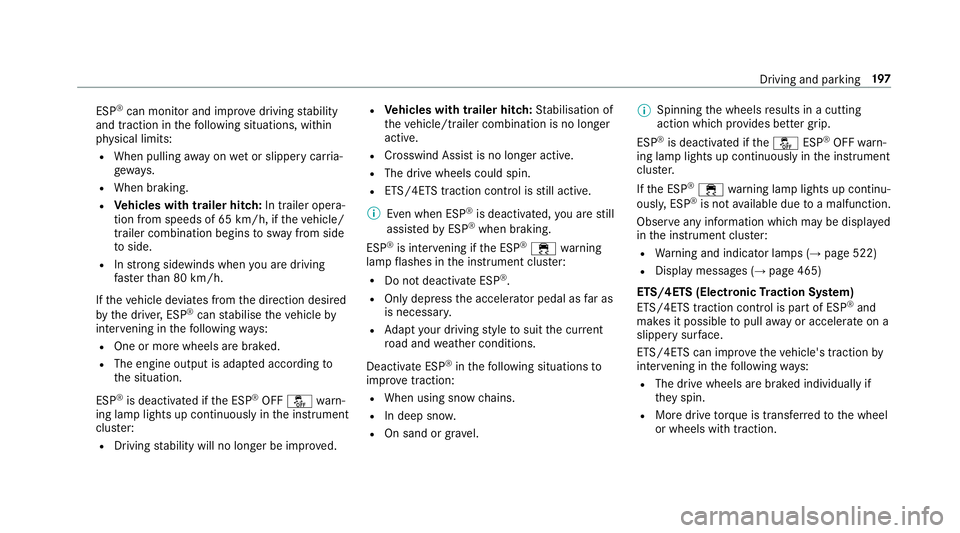
ESP
®
can moni tora nd impr ovedriving stability
and traction in thef ollowing situations, within
ph ysical limits:
R When pulling away on wetors lipper ycarria‐
ge wa ys.
R When braking.
R Vehicles with traile rhitch: In trailer opera‐
tion from speeds of 65 km/h ,ifthevehicle/
trailer combination begins tosw ay from side
to side.
R Instro ng sidewinds when youa redriving
fa ster than 80 km/h.
If th ev ehicle deviates from thed irection desired
by thed rive r,ESP ®
can stabilise thev ehicle by
inter vening in thef ollowing ways:
R One or mor ewheels ar ebrake d.
R The engine output is adap teda ccording to
th es ituation.
ESP ®
is deactivated if theE SP®
OFF å warn‐
ing lam plight supc ontinuousl yinthe instrument
clus ter:
R Driving stabilit ywill no lon gerbei mprove d. R
Vehicles with traile rhitch: Stabilisation of
th ev ehicle/trailer combinatio nisnol onger
active.
R Crosswind Assis tisnolonger active.
R The driv ewheels could spin.
R ETS/4ETS traction control is still active.
% Even when ESP ®
is deactivated, youa restill
assis tedbyE SP®
when braking.
ESP ®
is inter vening if theE SP®
÷ warning
lam pflashes in thei nstrument clus ter:
R Do no tdeacti vate ESP ®
.
R Only depress thea ccelera torp eda lasf ar as
is necessar y.
R Adapty our driving styletos uitthec urrent
ro ad and weather conditions.
Deactivat eESP®
in thef ollowing situations to
impr ovetraction:
R When using sno wchains.
R In deep sno w.
R On sand or gr avel. %
Spinning thew heels results in acutting
action whic hprovide sbette rg rip.
ESP ®
is deactivated if theå ESP®
OFF warn‐
ing lam plight supc ontinuousl yinthe instrument
clus ter.
If th eE SP®
÷ warning lam plight supc ontinu‐
ousl y,ESP ®
is no tavailable due toam alfunction.
Obse rvea nyinformation whic hmaybe displa yed
in thei nstrument clus ter:
R Warning and indicator lamps (→ page522)
R Displa ymessages (→ page465)
ETS/4ET S(Electronic Tractio nSystem)
ETS/4E TStraction control is pa rtof ESP ®
and
makes it possible topull away or accelerat eona
slipper ysurface.
ETS/4ET Scan impr ovethev ehicle's traction by
inter vening in thef ollowing ways:
R The driv ewheels ar ebrake di ndividually if
th ey spin.
R Mor edrive torque is transferred tothew heel
or wheels wit htraction. Driving and parking
197
Page 201 of 585
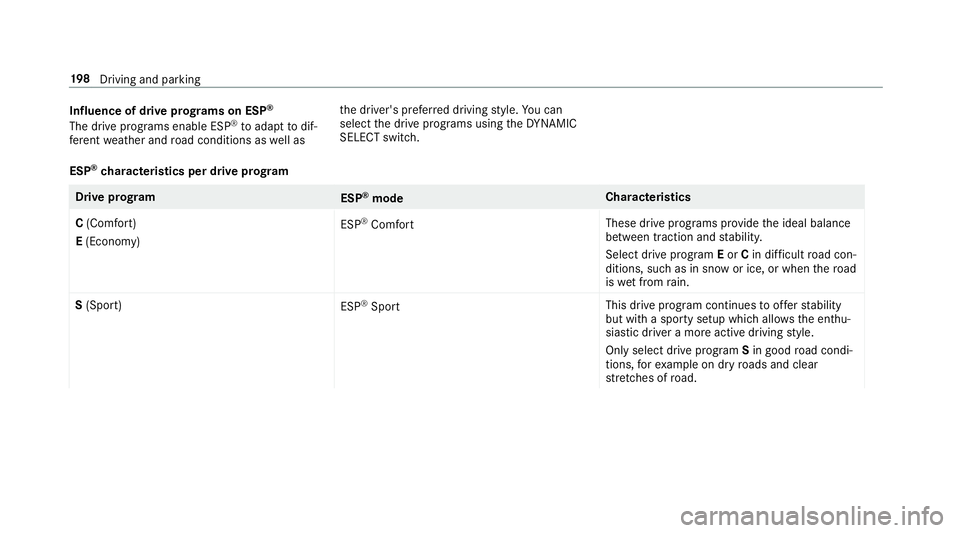
Influence of driv
eprograms on ESP ®
The driv eprograms enable ESP ®
to adap ttod if‐
fe re nt we ather and road condition saswell as th
ed rive r's prefer redd riving style. Youc an
select thed rive programs using theD YNAMIC
SELECT switch.
ESP ®
ch aracteristics per driv eprogram Driv
eprogram
ESP®
mode Characteristics
C (Com fort)
E (Economy) ESP
®
Comfort Thes
edrive prog rams pr ovide thei deal balance
between traction and stabilit y.
Select driv eprogram Eor Cin di fficult road con‐
ditions, suc hasinsnowori ce, or when ther oad
is we tfromr ain.
S (Sport)
ESP®
Sport This driv
eprogram continues tooffers tability
but wit hasporty setup whic hallows thee nthu‐
siastic driver amorea ctiv edriving style.
Onl yselect driv eprogram Sin goo droad condi‐
tions, fore xamp le on dr yroads and clear
st re tche sofr oad. 19 8
Driving and pa rking
Page 202 of 585
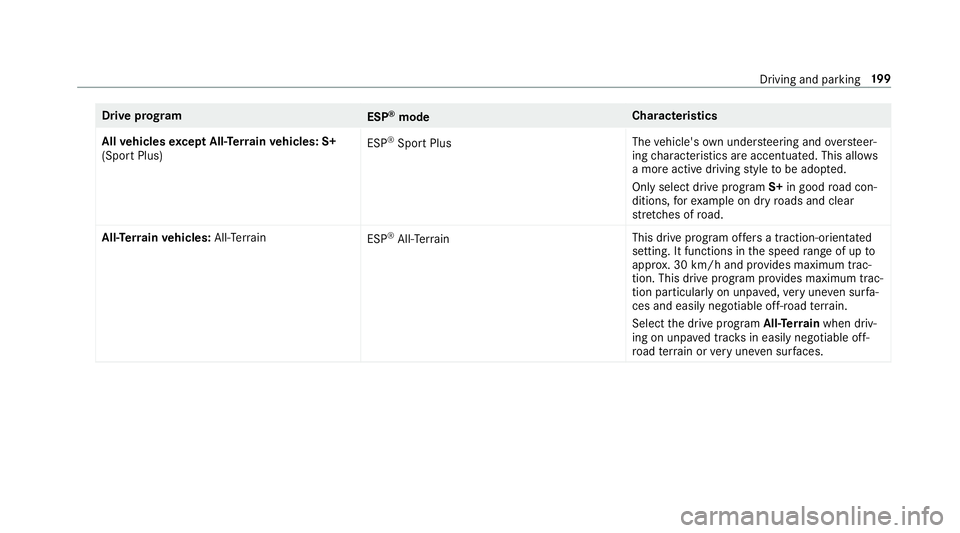
Driv
eprogram
ESP®
mode Characteristics
Al lv ehicles exceptA ll-Te rrain vehicles: S+
(Spor tPlus) ESP
®
Spor tPlus The
vehicle's ownu nder steering and oversteer‐
ing characteristic sareaccentuated. This allo ws
am orea ctiv edrivin gs tyle tobe adop ted.
Onl yselect driv eprogram S+in good road con‐
ditions, fore xamp le on dr yroads and clear
st re tche sofr oad.
All- Terrain vehicles: All-Terrain
ESP®
All- Terrain This driv
eprogram of fers at raction-o rientated
setting. It function sinthe speed rang eofupto
appr ox.30k m/h and pr ovides maximum trac‐
tion .This driv eprogram pr ovides maximum trac‐
tion particularly on unpa ved, very une vens urfa‐
ces and easil ynegotiable off- road terrain.
Select thed rive program All-Terra inwhen driv‐
ing on unpa vedt rack sine asily negotiable off-
ro ad terrain or very une vens urfaces. Drivin
gand parking 19 9
Page 203 of 585
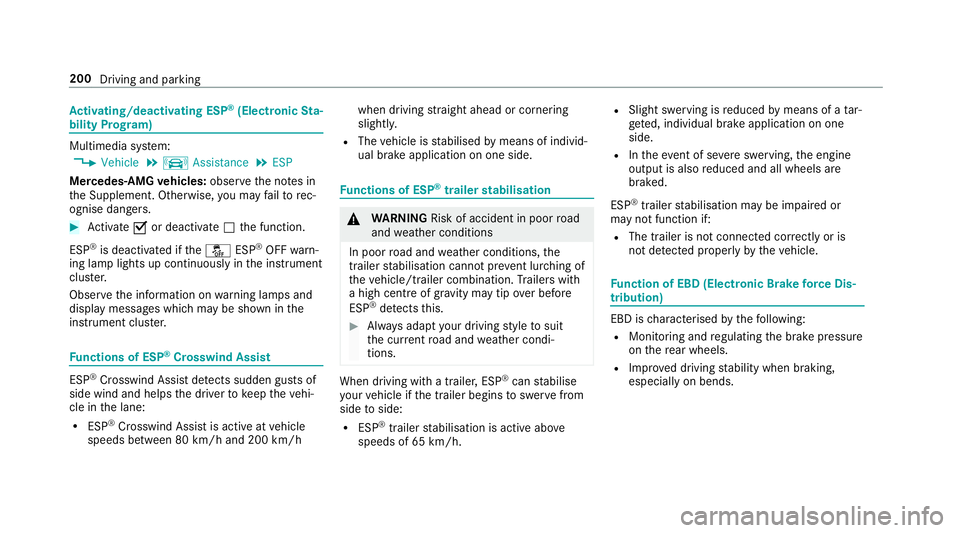
Ac
tivating/deactivatin gESP®
(Electronic Sta‐
bility Prog ram) Multimedia sy
stem:
, Vehicle .
k Assistance .
ESP
Mercedes‑AMG vehicles: observet he no tesin
th eS upplement .Otherwise, youm ayfailto rec‐
ognise dangers. #
Activate Oor deacti vate ª thef unction.
ESP ®
is deactivated if theå ESP®
OFF warn‐
ing lam plight supc ontinuousl yinthe instrument
clus ter.
Obser vethei nformation on warning lamps and
displa ymessages whic hmaybe shown in the
instrumen tclus ter. Fu
nctions of ESP ®
Crosswind Assist ESP
®
Crosswind Assis tdetects sudden gusts of
side wind and helps thed rive rtok eepthev ehi‐
cle in thel ane:
R ESP ®
Crosswind Assis tisactiveatv ehicle
speeds between 80 km/h and 200 km/h when driving
stra ight ahead or cornering
slight ly.
R The vehicle is stabilise dbym eans of individ‐
ualb rake application on one side. Fu
nctions of ESP ®
trailer stabilisation &
WARNING Risk of accident in poo rroad
and weather conditions
In poor road and weather conditions, the
traile rstabilisation canno tpreve nt lu rching of
th ev ehicle/trailer combination. Trailer swith
ah igh centr eofgravity ma ytipove rbefore
ESP ®
de tects this. #
Alw aysa dap tyour driving styletos uit
th ec urrent road and weather condi‐
tions. When drivin
gwithat railer ,ESP ®
can stabilise
yo ur vehicle if thet railer begins toswer vefrom
side toside:
R ESP ®
trailers tabilisation is activ eabove
speeds of 65 km/h. R
Slight swerving is reduced bymeans of atar‐
ge ted, individual brak eapplication on one
side.
R Inthee vent of se vere swerving, thee ngine
output is also reduced and all wheels are
braked.
ESP ®
trailer stabilisation ma ybeimpaired or
ma ynotfunction if:
R The trailer is no tconnec tedc orrectly or is
no td etected properly bythev ehicle. Fu
nction of EBD (Electronic Brak eforce Dis‐
tribution) EB
Disc haracterised bythef ollowing:
R Monitoring and regulating theb rake pressure
on ther ear wheels.
R Impr oveddriving stabilit ywhen braking,
especiall yonb ends. 200
Drivingand parking
Page 204 of 585
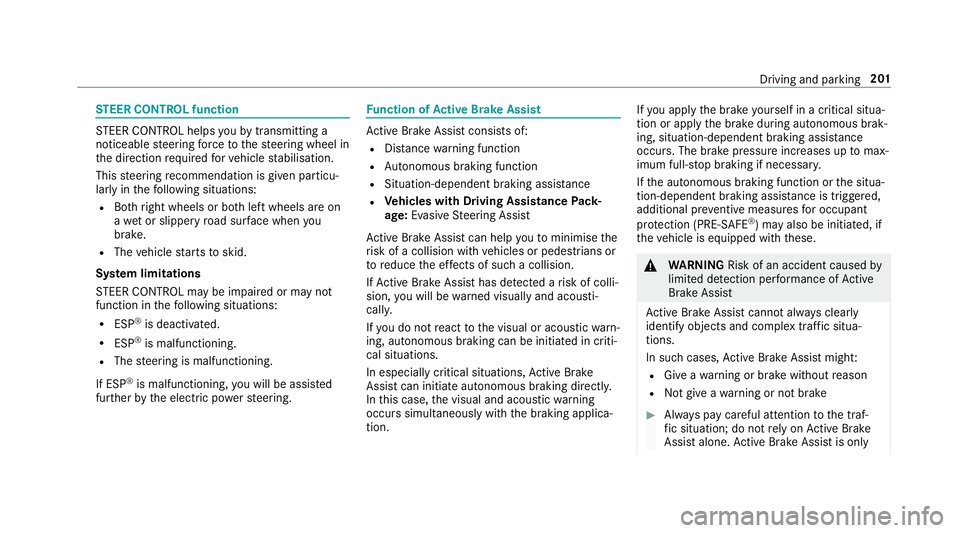
ST
EER CONT ROLfunction ST
EER CONTROL help syou bytransmitting a
noticeable steering forc etot hesteering wheel in
th ed irection requ ired forv ehicle stabilisation.
This steering recommendation is given pa rticu‐
larly in thef ollowing situations:
R Both right wheels or bo thleftw heels ar eon
aw etor slippe ryroad sur face whe nyou
brake.
R The vehicle starts toskid.
Sy stem limitations
ST EER CONTROL ma ybeimpairedorm aynot
function in thef ollowing situations:
R ESP ®
is deactivated.
R ESP ®
is malfunctioning.
R The steering is malfunctioning.
If ESP ®
is malfunctioning, youw ill be assis ted
fur ther by thee lectric po wersteering. Fu
nction of Activ eB rake Assi st Ac
tiveB rake Assi stconsi stso f:
R Distance warning function
R Autonomous braking function
R Situation-dependent braking assi stance
R Vehicles with Drivin gAssistanc ePack‐
age: Evasi veSteering Assist
Ac tiveB rake Assi stcan hel pyou tominimis ethe
ri sk of acollision wit hvehicles or pedestrians or
to reduce thee ffects of suc hacollision.
If Ac tiveB rake Assi sthas de tected arisk of colli‐
sion ,you will be warned visually and acousti‐
cally.
If yo udon otreact tothev isual or acoustic warn‐
ing, autonomous brakin gcan be initiated in criti‐
cal situations.
In especially critical situations ,Activ eBrake
Assi stcan initia teautonomous brakin gdirect ly.
In this case, thev isual and acoustic warning
occur ssimultaneousl ywitht he braking applica‐
tion. If
yo ua ppl ythe brak eyourself in acritical situa‐
tio nora pplythe brak eduring autonomous brak‐
ing, situation-dependen tbraking assis tance
occu rs.T he brak epressur eincreases up tomax‐
imum full-s topb raking if necessar y.
If th ea utonomous braking function or thes itua‐
tion-dependen tbraking assis tance is trig gered,
additional pr eventiv emeasures foro ccupant
pr otection (PRE-SAFE ®
)m ayalso be initiated, if
th ev ehicle is equipped wit hthese. &
WARNING Risk of an accident caused by
limited de tection per form anc eofA ctive
Brak eAssist
Ac tiveB rake Assi stcanno talway sc learly
identify objects and compl extraf fics itua‐
tions.
In su chcases, ActiveB rake Assi stmight:
R Giveaw arning or brak ewithout reason
R Notgiveaw arning or no tbrake #
Alw aysp aycareful attention tothet raf‐
fi cs ituation; do no trely on ActiveB rake
Assi stalone. ActiveB rake Assi stis only Drivin
gand parking 201
Page 205 of 585
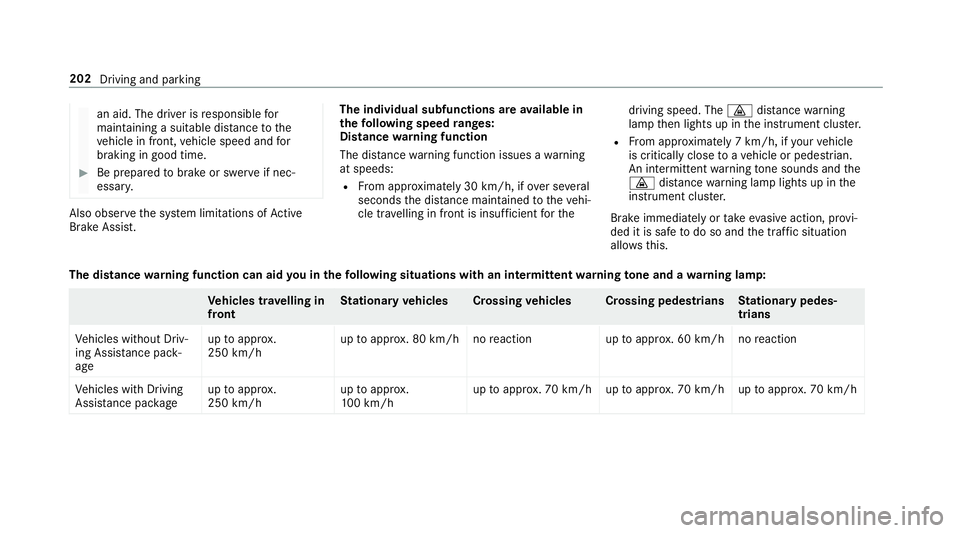
an aid. The driver is
responsible for
maintaining asuita ble dis tance tothe
ve hicle in front, vehicle speed and for
braking in good time. #
Be prepared tobrak eors werveifn ec‐
essar y. Als
oo bserve thes ysteml imitations of Active
Brak eAssist. The individua
lsubfunctions ar eavailable in
th ef ollowing speed ranges:
Distance warning function
The dis tance warning function issues awarning
at speeds:
R From appr oximatel y30k m/h, if overseveral
seconds thed ista nce maintained tothev ehi‐
cle tra velling in front is insuf ficient fort he driving speed. The
·distance warning
lam pthen lights up in thei nstrument clus ter.
R From appr oximatel y7km/h, if your vehicle
is criticall yclose toav ehicle or pedestrian.
An intermittent warning tone sounds and the
· distance warning lam plight supint he
instrument clus ter.
Brak eimmediately or take evasiv eaction ,provi‐
ded it is saf etodosoa ndthet raffic situation
allo wsthis.
Th ed istance warning function can aid youint hefollowing situations wit hanintermit tent wa rning tone and awarnin glamp: Ve
hicles tr avelling in
front St
ationar yvehicles Crossin gvehicles Crossin gpedestrians Stationar ypedes‐
trians
Ve hicles without Driv‐
ing Assis tance pa ck‐
age up
toappr ox.
250 km/h up
toappr ox.80k m/h no reaction uptoappr ox.60k m/h no reaction
Ve hicles wit hDriving
Assis tance pa ckage up
toappr ox.
250 km/h up
toappr ox.
10 0k m/h up
toappr ox.70k m/h up toappr ox.70k m/h up toappr ox.70k m/h 202
Driving and pa rking
Page 207 of 585

Cancelling
abrake application of Active
Brak eAssist
Yo uc an cancel abrake applicatio nofActive
Brak eAssistat an ytimeb y:
R Fullyd epressin gthe accelerator pedal or
wit hk ickdown.
R Vehicles without Drivin gAssistanc epack‐
age: releasing theb rake pedal
Ac tiveB rake Assi stma ycancel theb rake appli‐
cation when one of thef ollowing condition sis
fulfilled:
R Youm anoeuv retoavoid theo bstacle.
R The reis no longer arisk of collision.
R An obs tacle is no longer de tected in front of
yo ur vehicle.
Evasiv eSteering Assis t(onl yvehicles with
Driving Assistan cePackage)
Evasi veSteering Assis thas thef ollowing charac‐
te rist ics:
R Can de tect stationar yorcrossing pedes‐
trians. R
Can assis tthe driver wit hadditional steering
assis tance if it de tects aswerving manoeu‐
vre.
R Canbea ctivatedbyana bruptsteering mo ve‐
ment during aswerving manoeuvre.
R Cana ssistduring swerving and stra ightening
of thev ehicle.
R Can react from aspee dofa pproximately
20 km/h up toas pee dofa pproximately
70 km/h.
Yo uc an pr eventthea ssis tance at an ytime by
activel ysteering. &
WARNING Risk of an accident despi te
Evasiv eSteering Assist
Evasiv eSteering Assis tcann otalw aysc learly
identify objects and comple xtraffic situa‐
tions.
In addition ,the steering suppor tofEvasive
St eering Assis tisgenerallyn otsufficien tto
avo idac ollision. In suc
hcases Evasiv eSteering Assis tcan:
R giveanu nnecessar ywarning or pr ovide
assis tance
R notg iveaw arning or no tprovide assis‐
ta nce #
Alw aysp aycareful attention tothet raf‐
fi cs ituation; do no trely on Evasive
St eering Assis talone. #
Beready tobrak eand take evasive
action ,ifnecessar y. #
Preve ntthea ssis tance byactivel ysteer‐
ing in non-critical driving situations. #
Driv eatana ppropriat espeed if pedes‐
trians ar eclose tothep athofy ourvehi‐
cle. Also obser
vethes ysteml imitations of Evasive
St eering Assist. 204
Driving and parking
Page 210 of 585
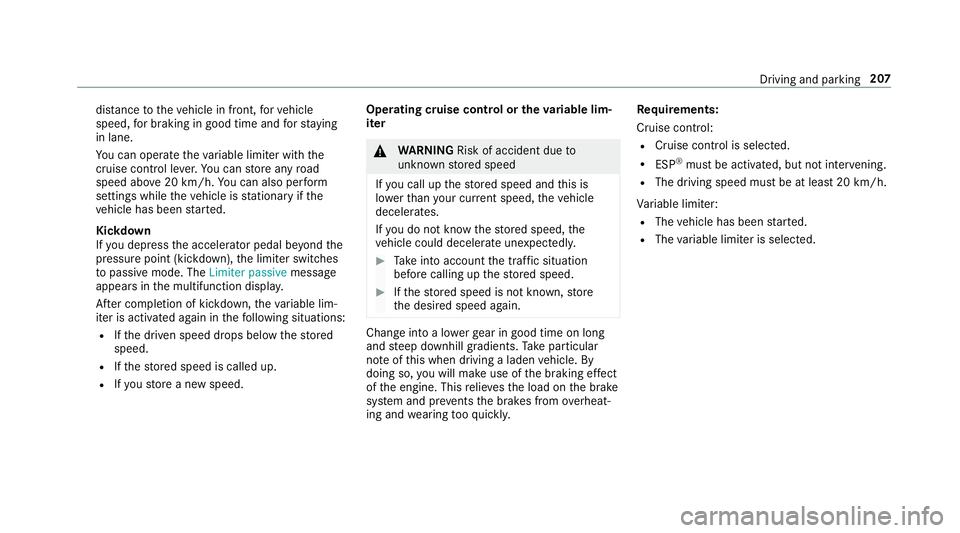
dis
tance tothev ehicle in front, forv ehicle
speed, forb raking in good time and fors taying
in lane.
Yo uc an operat ethe variable limiter wit hthe
cruise control le ver.Yo uc an stor ea nyroad
spee dabove 20 km/h. Youc an also per form
settings while thev ehicle is stationar yifthe
ve hicle has been star ted.
Kickdown
If yo ud epress thea ccelerator pedal be yond the
pressur epoint (kickdown), thel imiter switches
to passiv emode. The Limiter passive message
appear sinthe multifunction displa y.
Af terc ompletion of kickdown, thev ariable lim‐
iter is activated again in thef ollowing situations:
R Ifth ed rive ns peed drops belo wthe stored
speed.
R Ifth es tore ds peed is called up.
R Ifyo us tore an ew speed. Operating cruise control or
thev ariable lim‐
iter &
WARNING Risk of accident du eto
unknown stored speed
If yo uc all up thes tore ds peed and this is
lo we rthan your cur rent speed ,the vehicle
decelerates.
If yo udon otknow thes tore ds peed, the
ve hicle could decelerat eunexpectedly. #
Take intoa ccount thet raffic situation
befor ecallin gupt hestored speed. #
Ifth es tore ds peed is no tknown, store
th ed esired speed again. Chang
eintoal owergear in good time on long
and steep downhill gradients. Take particular
no te ofthis when drivin galaden vehicle. By
doing so, youw ill mak euse of theb raking ef fect
of thee ngine. This relie vest he load on theb rake
sy stem and pr events theb rake sf romo verheat‐
ing and wearing tooq uickl y. Re
quirements:
Cruise control:
R Cruise control is selected.
R ESP ®
mus tbea ctivated, but no tinter vening.
R The driving speed mu stbe at leas t20k m/ h.
Va riable limiter:
R The vehicle has been star ted.
R The variable limiter is selec ted. Driving and parking
207